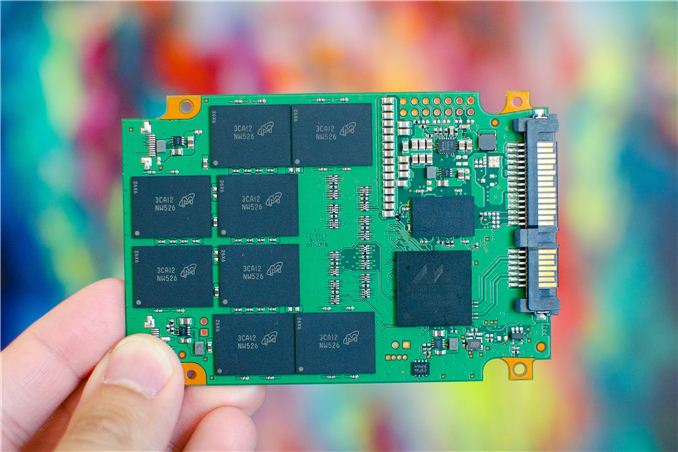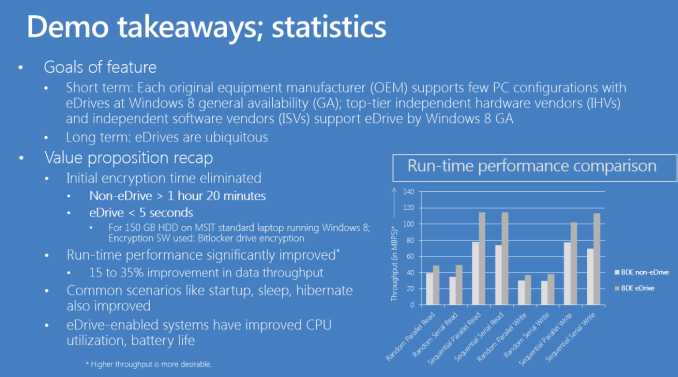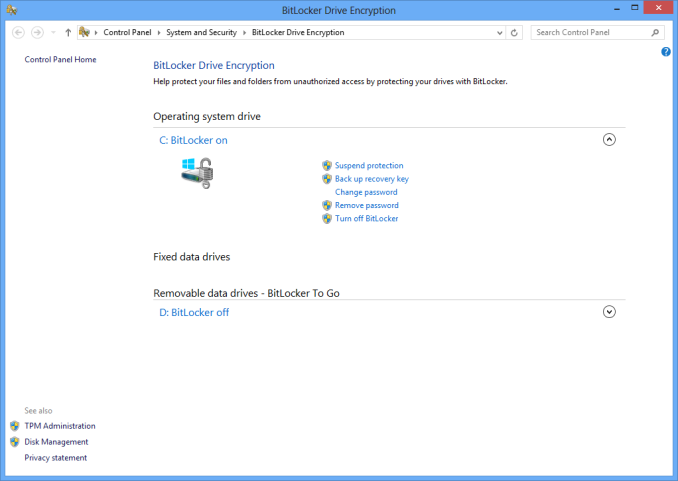Hardware Accelerated BitLocker Encryption: Microsoft Windows 8 eDrive Investigated with Crucial M500
by Anand Lal Shimpi on April 10, 2013 1:28 PM EST
Most modern SSDs come with some form of hardware encryption. On these drives with hardware encryption, it’s usually permanently turned on - all data written to the NAND is typically stored in encrypted form. This stems from the fact that all writes to NAND had to be scrambled to begin with (writing long repeated strings of data to NAND can cause problems for data retention). The earliest implementations weren’t sophisticated enough to be considered real encryption, but these days it’s not uncommon to see hardware AES-128/256 support.
The bad news has been that relying on OS driven filesystem encryption always meant the use of software encryption on top of your drive’s native encryption. This was particularly a problem on SandForce based drives, where full disk encryption basically ruined any of the performance advantages of the controller’s native compression/de-dupe (you can’t further reduce encrypted data). Other drives suffered (just not as much) due to the added overhead from having to leverage the host CPU to encrypt all data before writing it to disk. There’s also the fact that if you encrypt your entire drive (free space included), the drive ends up looking like a completely full drive - which has performance implications of its own. This was the world that existed with BitLocker under Windows 7 and FileVault under OS X.
With Windows 8, the story is a bit different.
I hadn’t heard of Microsoft’s eDrive standard for Windows 8 until I started working on the Crucial M500 review. It turns out that if you have a storage device (e.g. SSD, eMMC, etc...) that meets the right encryption standards, Windows 8’s BitLocker will leverage the device’s hardware encryption engine, bypassing the software based encryption altogether. The result should be better performance and lower power consumption.
The M500 is the first drive that I’m aware of to support Microsoft’s eDrive standard. Because of its TCG Opal 2.0 and IEEE-1667 compliance, the M500 is eDrive compatible. There are some platform requirements to get eDrive working as well. You’ll obviously need a system that will support BitLocker (although hardware TPM isn’t necessary, you can still go the USB key route). It’s important to note that you have to enable UEFI boot and make sure you have a UEFI enabled Windows 8 install in order for this to work. Your platform will specifically need to support UEFI 2.3.1 (Class II no CSM/Class III). Often times UEFI boot support on motherboards can be tricky, particularly on earlier firmware revisions, so be sure you’re updated (this was the problem I ran into with my test hardware). I've had varied luck with getting DIY desktop PC hardware to behave appropriately with UEFI and BitLocker enabled, so your mileage may vary. The experience on a TPM enabled notebook should be far cleaner from what I've heard.
With all of your ducks in a row, all you need to do is enable BitLocker at this point. If everything is eDrive compliant you won’t be asked whether or you want to encrypt all or part of the drive, after you go through the initial setup BitLocker will just be enabled. There’s no extra encryption stage (since the data is already encrypted on your SSD). If you’ve done something wrong, or some part of your system isn’t eDrive compliant, you’ll get a progress indicator and a somewhat lengthy software encryption process.
For example, with 107GB in use my test 240GB M500 was fully encrypted with BitLocker enabled after a couple of seconds. Just a pause, then boom, BitLocker was enabled. My 256GB Samsung SSD 840 Pro on the other hand took about 21 minutes to encrypt the very same data using software encryption.
The gallery below shows all of the steps I went through to enable BitLocker/eDrive support on my Intel DX79SI motherboard with Crucial’s M500.
The ability to quickly enable/disable BitLocker is a nice perk, but it’s only part of the story. There’s basically no change in performance with BitLocker enabled on the M500 since the encryption is all done on the drive (and was always being done there to begin with).
| PCMark 7 - Raw System Storage Score | |||||||||||||
| Unencrypted | BitLocker Enabled | Perf Impact | |||||||||||
| Crucial M500 240GB (eDrive) | 4644 | 4586 | -1.2% | ||||||||||
| Samsung SSD 840 Pro 256GB | 6195 | 5336 | -13.9% | ||||||||||
The sad reality is, Samsung’s 256GB 840 Pro with software encryption enabled ends up being faster than the M500 running as an eDrive, but in theory if the drives were equal performers you’d see a clear advantage to the eDrive compliant hardware. PCMark 7 isn’t the most stressful test and we’re really only measuring peak performance here however. Given that the 840 Pro should look like a completely full drive with its free space encrypted, I ran a short 4KB random write test to see whether or not that was the case:
| Peak Performance - 4KB Random Write (8GB LBA Space, QD32) | |||||||||||||
| Unencrypted | BitLocker Enabled | Perf Impact | |||||||||||
| Crucial M500 240GB (eDrive) | 63334.8 IOPS | 62865.8 IOPS | -0.7% | ||||||||||
| Samsung SSD 840 Pro 256GB | 88911.3 IOPS | 63097.53 IOPS | -29.0% | ||||||||||
Now this is much more interesting. On a mostly empty drive, the 840 Pro behaves like it’s full of data and thus shows lower peak 4KB random write performance. The M500 on the other hand behaves like it’s empty. As neither one of these drives has the best behavior after extended usage in a full state, the long term performance benefits are tremendous.
There should be power savings associated with running as an eDrive, although since my testbed is a desktop PC they aren’t all that visible. The irony here is that none of the modern (UEFI 2.3.1 hit in mid 2011) PC notebook hardware I have on hand will support a 2.5" SSD.
As someone who regularly uses full disk encryption, I can’t tell you how excited I am at the thought of eDrive compliant SSDs. There’s absolutely no reason this shouldn’t be how all OS level encryption works. Kudos to Microsoft for making this happen and to Crucial for supporting it.
I’m hoping we’ll see more eDrive compliant SSDs in the future. For now, anyone who is required to run with BitLocker enabled should seriously consider Crucial’s M500.
On the Mac side, I do hope Apple will follow Microsoft’s lead here and build similar support in to OS X for FileVault. The power and performance savings are worth it, especially when you consider that SandForce based SSDs are now in Apple’s official parts bin.


















46 Comments
View All Comments
Braumin - Wednesday, April 10, 2013 - link
This is some pretty cool news actually. Now Bitlocker just needs to support smart card authentication at bootup and we can start using it.lecaf - Thursday, April 11, 2013 - link
Why would you want that?Sure smartcard for OS authentication is a good security feature, but reusing the same smart card for disk unlocking would be nonsense from a security standpoint, and using two would not be practical.
Araemo - Thursday, April 11, 2013 - link
Why would you want that? Because every additional password you give a user increases the chances of them writing it on a sticky note on the computer and bypassing your well-designed security.Without an ability to use your AD credentials for pre-boot authentication, I recommend my customers go TPM-only (with secure boot if supported) for that reason, plus the supportability reasons.
Technically, bitlocker supports smartcard-auth... as long as you have a third-party module running pre-bootmgr to authenticate the smartcard and supply the drive protector key to bootmgr.
I've seen no product that does this, however, so the above statement is more correct than microsoft's line. ;)
Braumin - Thursday, April 11, 2013 - link
How do you manage the PIN for 30,000 laptops? 100,000? Even 10 laptops? Just give everyone the same PIN and call it a day? What happens when an employee is fired? You just go re-pin all of your machines? Have them make (and then forget) their own PINs?lecaf - Friday, April 12, 2013 - link
There is a tool for that: Microsoft BitLocker Administration and Management (MBAM).It's a central DB storing recovery information and allow non administrators users to change the PIN.
Don't use the AD for storing recovery keys as they are stored in clear text.
Araemo - Friday, April 12, 2013 - link
MBAM is a necessity for deploying BitLocker in an enterprise environment. But it's not free. You have to buy MDOP.macshuffle - Sunday, April 21, 2013 - link
I rolled out MBAM globally for our environment. I'm currently looking to upgrade to the recently released MBAM v2.0 as it includes many fixes the original version should have had. It is easy to setup and install....just make sure you backup that key database and the encryption cert for it...otherwise your users will not be able to recover their systems. As another mentioned, you obtain MBAM by purchasing MDOP.Donald Duck - Monday, October 26, 2015 - link
Why bother, most computer has TPM chip (Trusted Platfrom Module) inside now these day. The TPM is a chip inside the computer acting as virtual smart card. All you need is Wave Systems virtual smart card software, then your computer is locked and safe as or better than most of the banks's computers. The combination of Self-encrypted SSD + Virtual Smart Card + Password will pretty much lock out the FBI and hackers out of your computer. Also, with Wave Systems Embassy, you can manage couple hundred thousand computers with no sweat. This has been around for a long time, and I am surprise that most people still don't know.Donald Duck - Monday, October 26, 2015 - link
Why bother, most computer has TPM chip (Trusted Platfrom Module) inside now these day. The TPM is a chip inside the computer acting as virtual smart card. All you need is Wave Systems virtual smart card software, then your computer is locked and safe as or better than most of the banks's computers. The combination of Self-encrypted SSD + Virtual Smart Card + Password will pretty much lock out the FBI and hackers out of your computer. Also, with Wave Systems Embassy, you can manage couple hundred thousand computers with no sweat. This has been around for a long time, and I am surprise that most people still don't know. Why bother, most computer has TPM chip (Trusted Platfrom Module) inside now these day. The TPM is a chip inside the computer acting as virtual smart card. All you need is Wave Systems virtual smart card software, then your computer is locked and safe as or better than most of the banks's computers. The combination of Self-encrypted SSD + Virtual Smart Card + Password will pretty much lock out the FBI and hackers out of your computer. Also, with Wave Systems Embassy, you can manage couple hundred thousand computers with no sweat. This has been around for a long time, and I am surprise that most people still don't know.Blindsay04 - Wednesday, April 10, 2013 - link
Very cool indeed, Any idea if this would work in windows 7 ultimate/enterprise as well or is it only bitlocker in windows 8?